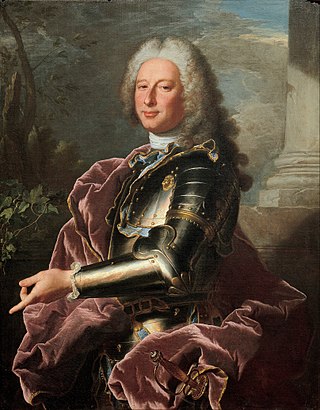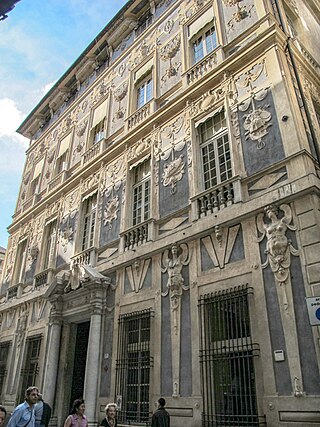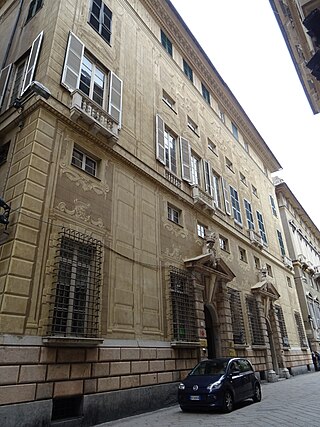
Bernardo Strozzi, named il Cappuccino and il Prete Genovese, was an Italian Baroque painter and engraver. A canvas and fresco artist, his wide subject range included history, allegorical, genre and portrait paintings as well as still lifes. Born and initially mainly active in Genoa, he worked in Venice in the latter part of his career. His work exercised considerable influence on artistic developments in both cities. He is considered a principal founder of the Venetian Baroque style. His powerful art stands out by its rich and glowing colour and broad, energetic brushstrokes.

Palazzo Bianco is one of the main buildings of the center of Genoa, Italy. It is situated at 11, via Garibaldi.

The Palazzo Brignole Sale or Palazzo Rosso is a house museum located in Via Garibaldi, in the historical center of Genoa, in Northwestern Italy. The palace is part of the UNESCO World Heritage Site Genoa: Le Strade Nuove and the system of the Palazzi dei Rolli. The rich art collection inside, along with the galleries of Palazzo Bianco and Palazzo Doria Tursi, is part of the Musei di Strada Nuova and consists of the works of artists of the caliber of Antoon van Dyck, Guido Reni, Paolo Veronese, Guercino, Gregorio De Ferrari, Albrecht Dürer, Bernardo Strozzi and Mattia Preti.

Genoa: Le Strade Nuove and the system of the Palazzi dei Rolli is a UNESCO World Heritage Site which includes a number of streets and palaces in the center of Genoa, in Northwestern Italy.

Genoa is a city in and the capital of the Italian region of Liguria, and the sixth-largest city in Italy. In 2023, 558,745 people lived within the city's administrative limits. While its metropolitan city has 813,626 inhabitants, more than 1.5 million people live in the wider metropolitan area stretching along the Italian Riviera.

The Palazzo Doria or Palazzo Andrea e Gio. Batta Spinola is a palace located in Via Garibaldi, in the historical center of Genoa, in Northwestern Italy. It was one of the 163 Palazzi dei Rolli of Genoa, the selected private residences where the notable guests of the Republic of Genoa were hosted during State visits. On 13 luglio del 2006 it was included in the list of 42 palaces which now form the UNESCO World Heritage Site Genoa: Le Strade Nuove and the system of the Palazzi dei Rolli.

The Palazzo Spinola di Pellicceria, also known as Palazzo Francesco Grimaldi, is a palace located in piazza di Pellicceria in the historical center of Genoa, Northwestern Italy. The palace was one of the 163 Palazzi dei Rolli of Genoa, the selected private residences where the notable guests of the Republic of Genoa were hosted during State visits. On 13 luglio del 2006 it was added to the list of 42 palaces which now form the UNESCO World Heritage Site Genoa: Le Strade Nuove and the system of the Palazzi dei Rolli. It is currently owned by the Ministry of Cultural Heritage and Activities and Tourism and houses the National Gallery of Art in Palazzo Spinola.

The Musei di Strada Nuova in the Italian city of Genoa comprise three museums which together form a single complex, housed in the Palazzo Rosso, the Palazzo Bianco and the Palazzo Tursi, all of which are located along the Via Garibaldi. The Palazzo Tursi is also Genoa's city hall.

The Penitent Magdalene is a marble sculpture of Mary Magdalene by Antonio Canova, about 90 cm high, known in two final versions, now in Genoa and St Petersburg.

Maria Brignole Sale De Ferrari, Duchess of Galliera was an Italian noblewoman and philanthropist. She enabled the foundation of the first museums in her birthplace of Genoa, the Palazzo Rosso and Palazzo Bianco as well as the Galliera Hospital and the San Filippo children's hospital. A statue of her by Giulio Monteverde stands in the hospital gardens.

The palazzo Doria-Tursi or palazzo Niccolò Grimaldi is a building on Via Giuseppe Garibaldi in the historic town centre of Genoa. With Palazzo Rosso and Palazzo Bianco it houses the Strada Nuova Museums and on 13 July 2006 all three palaces and the streets around them became the Genoa: Le Strade Nuove and the system of the Palazzi dei Rolli World Heritage Site. Since 1848 Palazzo Doria-Tursi has also housed the city hall of Genoa.
Ezia Gavazza was an Italian art historian. Along with her friends and colleagues Lauro Magnani and Piero Boccardo, she was one of the most prolific writers in Genoa on Baroque art. She specialised in the Ligurian Baroque, particularly Domenico Piola, Giulio Benso, Giovanni Andrea Ansaldo, Grechetto and Bernardo Strozzi.

Rodolfo Emilio Brignole Sale, marquis of Groppoli, was the 167th Doge of the Republic of Genoa from 25 November 1762 to 25 November 1764.

Giovanni Francesco II Brignole Sale, was the 158th Doge of the Republic of Genoa and the last king of Corsica.

Madonna and Child with Saints is a c. 1520-1522 oil on panel painting by Palma Vecchio, now in the Palazzo Rosso in Genoa.

The Dying Cleopatra or The Death of Cleopatra is a c. 1648 oil on canvas painting by Guercino, now in the Palazzo Rosso in Genoa.

The Suicide of Cato is a 1641 oil on canvas painting, now in the Palazzo Rosso in Genoa.

Saint Sebastian is a c. 1615 oil on canvas painting by Guido Reni, now in the Capitoline Museums in Rome. It is one of three similar treatments of the subject produced by the artist - the others are now in the Palazzo Rosso in Genoa (c.1615) and another in the Rhode Island School of Design Museum in Providence.

The palazzo Podestà or Nicolosio Lomellino is a building located in via Garibaldi (Genoa) at number 7 in the historical centre of Genoa, included on 13 July 2006 in the list of the 42 palaces inscribed in the Rolli di Genova that became World Heritage by UNESCO on that date.

The palazzo Cattaneo-Adorno or palazzo Lazzaro e Giacomo Spinola is a building located on via Garibaldi, in the historical centre of Genoa, marked by house numbers 8 and 10, included on 13 July 2006 in the list of 42 palaces inscribed in the Rolli di Genova, which became World Heritage by UNESCO on that date. It houses a remarkable cycle of Baroque frescoes by Lazzaro Tavarone.




















